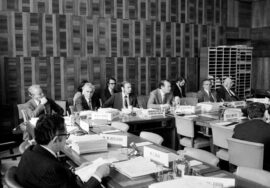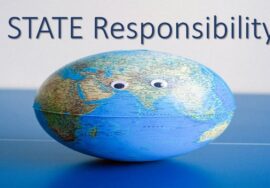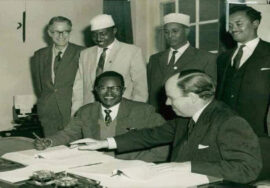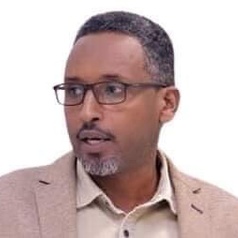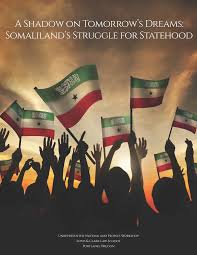
Reflections of Somaliland Statehood
Reflections of Somaliland Statehood
The author Dimitrios Lalos used a false premise start of its law paper: This Note recognizes that under international law, Somaliland is subject to the rule of law of the parent state, a rule firmly established by the Supreme Court of Canada in Reference re Secession of Quebec. The Supreme Court of Canada, however, also developed remedial secession theory as a mechanism to enable a minority region to negotiate secession with the parent state.
Which is: the theory of remedial secession is that of the Supreme Court of Canada. in the Quebec case. In its 1998 judgement, the Court affirmed that there. exists no right to unilateral secession in international law.
However, that statement is completely false in the international law: When two countries merge into one, they don’t necessarily create a “parent state” in the traditional sense. Instead, they often form a new, independent state that becomes the successor to the previous entities. This new state would be the direct successor to the merged countries, inheriting their territorial claims and responsibilities.
Which is: When Somaliland who gains it independence 26th June 1960 and Somalia in 1st July 1960 merged, they became new entity called: Somali Republic. But, then Somalia violated the terms of their own union:
- Somali Republic was changed to Somalia
- Somalia violated many national and international law not following their illegal not signed by Somaliland act of union as well as the not valid referendum in 1961.
- Again, Somalia Siyad Barre initiated a military coup annihilated the constitution, legal government making Somaliland independent since 1960s up to 1969 according to the international law. Somalia just annexe Somaliland without repercussion of the international community. Therefore, Somaliland liberated itself 1991 with its own military capability, and reclaim its independence of 1960s
BETWEEN STATEHOOD AND SOMALIA: REFLECTIONS OF SOMALILAND STATEHOOD
I. INTRODUCTION
At independence during 1960s, Somalia—officially the Somali Republic after the union of former British Somaliland in the North and former Italian Somalia in the South—was regarded as one of the least likely African countries to fall into the category of a ―failed state. The majority of Somalians are ethnically Somali; they share a similar adherence to Sunni Islam and nomadic pastoralism. Below these surface similarities, however, a deep division in history exists between the northern Somaliland and all Somalia. This division between Somaliland and Somalia has not only created tension in government, it has also led to civil war. Out of the ashes of the North-South violence, Somaliland emerged as a de facto state. Saddled with early political and economic challenges, Somaliland ―has [since instituted] its own democratic government, police force, army, financial system, and currency. During the same period, Somalia has effectively ceased to exist.
II. HISTORICAL SETTING
Beginning in the late nineteenth century, the British began colonizing Somaliland. Because British interest was limited to coastal regions, its civil administration was rather lenient. As a result, traditional societal structures were kept autonomous from British rule. To fund its administration, however, the British relied heavily on imperial treasuries, resulting in the stagnation of the colony.
For a short period during the Second World War, the Italian government occupied British Somaliland. Within a year, however, British forces had reestablished control over the region. Following the war, British Somaliland was restored to protectorate status in 1948 while Italian Somaliland was placed under UN trusteeship. The trusteeship was intended to bring Italian Somaliland to independence. During this time, British interest in the North began to wane, accelerating the timetable for independence.
Illegal union: On June 26, 1960, British Somaliland declared independence, and five days later, it united with Italian Somaliland to form the Somali Republic. After unification, the North drafted an Act of Union, sending it to the capital, Mogadishu. The document was never ratified by the legislative assembly in the South. Instead, the South passed the Atto di Unione, which differed significantly from the North‘s Act of Union. Following its passage, the North became increasingly ―dissatisfied with the progress of the union argu[ing] that the act carried no force in the [N]orth because it had not been approved by the Somaliland legislature.
The North emphasized this dissatisfaction by boycotting the constitutional referendum. On October 15, 1969, Somalia‘s parliamentary experiment came to an abrupt end with the assassination of President Sharmarke. The new regime that seized power immediately suspended the constitution, imprisoned politicians, banned all political parties, and systematically deprived the North of development funds, causing a rapid deterioration in North-South relations. In response to Barre‘s repressive regime, the Isaaq clan formed the Somaliland National Movement (―SNM‖). In 1988, the SNM launched an offensive on Hargeysa and Burco. In an effort to undermine SNM support, Barre launched fighter pilots to bomb civilians throughout Somaliland. Ultimately, the SNM resistance and government counterattacks left ―50,000 dead in Hargeysa and hundreds of thousands dead in the rest of Somaliland. The civilians that survived the regime‘s bombings were rounded up in the streets and shot. Despite serious losses, in 1991 the SNM recaptured all major northern towns, bringing an end to North-South bloodshed.
In May 1991, the SNM convened the Great Conference of the Northern Peoples. At the conference, Somaliland revoked the Act of Union, and declared reclaiming its independence. Despite severing ties, Somaliland still faced considerable difficulties. Its infrastructure had been largely destroyed, a large amount of its population had fled, its army was without pay, and external aid was necessary to resurrect the economy. The SNM administration was also charged with drafting a national constitution. In light of these challenges, violence erupted. To restore peace, the government expanded representation to include ―some 500 persons representing elders, religious leaders, politicians, retired civil servants, intellectuals, businessmen, and others. These representatives agreed to establish a bicameral legislature to work with the President under an interim Constitution. At the conclusion of this interim term, the Assembly of Elders appointed Mohamed Egal to be President.
III. GAINING RECOGNITION AS A STATE
A. Theories of Recognition
Two competing branches of statehood theory exist, each emphasizing the importance of recognition differently. Declaratory theory is premised on the objective criteria outlined under the Montevideo Convention. Conversely, constitutive theory provides that statehood is dependent on recognition by the international community. Despite widespread competition over theory application, no consensus has emerged.
1. Declaratory Theory
Declaratory theory is favored by most commentators, including the International Court of Justice (―ICJ‖). Under declaratory theory, statehood is recognized when four conditions are met, regardless of international consent. For a state to be recognized under the criteria initially contemplated at the Montevideo Convention, it must have (a) a permanent population, (b) a defined territory, (c) government, and (d) capacity to enter into relations with the other states. First under these criteria, a territory-seeking statehood must demonstrate that it possesses a permanent population. Permanence consists of two points: (1) a permanent population that intends on inhabiting the territory permanently, and (2) a habitable territory.
The second criterion for statehood, a defined territory, is lenient. Despite the importance of territorial sovereignty, it is not a necessary prerequisite. In addition, the external boundaries of the state need not be explicitly defined. In the North Sea Continental Shelf Cases, the ICJ held that there is ―no rule that the land frontiers of a State must be fully delimited and defined, and often . . . for long periods they are not . . . .
The third criterion is the existence of a government. A state is not required to follow any particular pattern of governance, however, it must assert authority effectively.86 Effective governance consists of two points:
(1) internal governance, and (2) external governance. Internal governance is premised on the government‘s ability ―to establish and maintain a legal order . . . . External governance focuses on the government‘s ability to act autonomously. Ultimately, it is ―[t]he existence of functioning . . . administrative and legislative organs [that] will in general be a strong indicator for effective governance.
The final criterion for statehood is the capacity to enter into international relations.91 This language, however, betrays a requirement largely viewed as a consequence of statehood.92 As a result, theorists have argued whether this requirement entails the capacity or the ability to enter into relations. In the opinion of the American Law Institute, this requirement refers to the capacity to enter into international relations.
Ultimately, under declaratory theory, once the territory has met all four conditions, recognition as a state is mandated regardless of international consent. In practice, however, it is more likely the state will not obtain ―international rights on the international plane until [it is] recognized. As a result, declaratory theory may simply subject the state to a series of subjective criteria before providing the international community final veto power.
2. Constitutive Theory
constitutive theory appears to more accurately reflect reality. This contention is borne out by the observation that ―only states sit on the United Nations Security Council, [and] only states petition the International Court of Justice . . . .
Despite the importance of recognition under constitutive theory, ardent supporters ―do not claim that recognition creates the State. Instead, existing states merely act as the gatekeepers to ensure that de facto states meet the criteria outlined under the Montevideo Convention.102 This de facto gatekeeper function makes recognition a political instrument, with powerful states effectively exercising veto power. It also means that until international ―personality‖ is granted, the state is not attributed any rights or duties. Ultimately, in absence of international recognition, a de facto state is unlikely to achieve complete statehood.
B. Uti Possidetis
After a state is recognized, the doctrine of uti possidetis ―provides that new States will come to independence with the same borders that they had Constitutive theory argues that statehood is not automatic, but rather requires recognition in the international community. This approach ―stems from the shift in international law doctrine from natural law to the positivist theory, which is centered on consent as the essential element . . . .‖ Ultimately, while declaratory theory draws support from theorists, when they were . . . territories of one colonial power. This allowed colonial powers to limit fragmentation while maintaining the stability of international borders. During decolonization, the consensus in Africa was to deny secession. This intention was emphasized in the Charter of the Organization of African Unity, which affirmed the principle of respect for the ―sovereignty and territorial integrity of each State and for its inalienable right to independent existence. And, the Cairo Resolution, which reaffirmed that ―all the states undertake to respect the boundaries exiting at . . . independen[ce].
An international boundary is established and assumes permanence through treaty or acquiescence. As post-colonial boundaries are formalized, uti possidetis is replaced by the concept of ―territorial integrity. Under the Covenant of the League of Nations, member states were required to ―preserve as against external aggression the territorial integrity and existing political independence of all Members of the League. Similarly, the UN prohibits challenging the territorial integrity of the state through the threat or use of force. In the context of Africa, ―territorial integrity‖ has resulted in a reluctance to support self- determination.
IV. SECESSION
A. Unilateral Secession
Under international law, absent exceptional circumstances, a minority population is not afforded the right to unilateral secession. Exceptional circumstances exist where people are oppressed or subject to colonial rule. Majority support within the secessionist region, however, is not sufficient. In the Ǻland Islands Question, the League of Nations held that ―international law does not recognize the right of national groups . . . to separate themselves from the state of which they form part by the simple expression of a wish. More recently, the UN has refused to admit a secessionist region against the wishes of the parent state. As a result, secession is primarily governed by the law of the parent state.
B. Remedial Secession
The concept of remedial secession is primarily focused on the ―right of a people to participate . . . in the decision-making processes of the State. Absent effective mechanisms, a minority population is often excluded from the economic and political processes of the state. They may also be subjected to domination or subjugation. Under remedial secession theory, these exclusions from participation in the government enable the minority region to form a state to govern itself. With the exception of Reference re Secession of Quebec, however, no international body has recognized a legal remedy through which a minority region may enforce its right to self-determination.
In Reference Re Secession of Quebec, the Supreme Court of Canada subjected ―the potentially destructive issue of secession to the rule of law. The Court held that if a ―clear majority‖ of a minority region favors secession, then the parent state government has a duty to negotiate the possible secession. In conducting negotiations, the government must consider the rule of law, democracy, federalism, and the protection of minority rights.
Where a minority group is ―denied meaningful access to the government to pursue their political, economic, social and cultural development‖ it may be able to secede unilaterally. In this regard, the concept of remedial secession mirrors ―dissolving secession.‖ Dissolving secession posits that ―a State [may be created] without the consent of the former sovereign, which in view of its collapse and lack of effective (central) governance has at least temporarily de facto ceased to exist as a State. Absent remedial or dissolving secession, state dissolution could effectively deny a minority region the right to petition for the right to secede.
The concept of ―internal colonialism‖ provides another variation of remedial secession theory. Under the internal colonialism approach, the―right to territorial separation of a people within an existing State is closely linked to certain elements of the traditional concept of colonialism. Internal colonialism has also been applied in certain circumstances to minority populations within a parent state.
A territory is prima facie non-self-governing if it is geographically separate and ethnically distinct from the ―country administering it‖. Geographical separateness has usually been taken to require separation across land or sea . . . but there is no good reason why other defining characteristics, including historical boundaries or de facto boundaries . . . might not also be relevant.
In the case of historical boundaries or ethnic groups, the minority region must be placed in the position or status of a subordinate. This subordinate status of the minority population causes internal colonialism to bear a striking resemblance to remedial secession theory.
Ultimately, however, the concept of ―[r]emedial secession envisions a scheme by which . . . international law recognizes a continuum of remedies ranging from protection of individual rights, to minority rights, and ending with secession as the ultimate remedy. It is the severity of the treatment of the minority population that will legitimize the right to self-determination. Therefore, the existence of certain circumstances permits remedial secession, but also explicitly prohibits unilateral secession.
V. THE RECOGNITION AND SECESSION OF SOMALILAND
A. Theories of Recognition
1. Somaliland Under Declaratory Theory
The Republic of Somaliland meets the requirements set forth under the Montevideo Convention. It has a permanent population, a defined territory, a functioning government, and has the ability to enter into relations with other states. As a result, declaratory theory should recognize the Republic of Somaliland as a state within the international community.
Somaliland meets the first criterion with its growing, yet defined, population despite the nomadic nature of its inhabitants. In 1999, Somaliland had a defined population of 3,390,000. Since then, Somaliland‘s defined population has likely experienced a marked increase due to continued repatriation. As the population of Somaliland has grown, various clan families have started to significantly identify with the territory. Indeed, Somaliland‘s large nomadic population poses no impediment to recognition because a substantial number of permanent inhabitants remain.
The second criterion is met because the territorial boundaries of Somaliland stretch 68,000 square miles, corresponding roughly to its colonial boundaries. The territory includes five former regions of Somalia, however, its eastern border has been the subject of constant dispute. As a result of this territorial conflict, ―it might be contested that Somaliland has a clearly defined territory. Nevertheless, international law does not require definitively drawn boundaries.
Somaliland also has a clearly defined government, thereby meeting the third criterion. The government has held a referendum on the constitution and staged several peaceful elections. In addition, the [g]overnment appears to have ―general control of its territory, to the exclusion of other entities[,‖] and to have established ―some degree of maintenance of law and order[;‖] furthermore, there seems to be internal stability, popular support for the government as evidenced by a free vote, and a working constitution.
Despite exercising territorial control, Somalia has never recognized Somaliland independence. Absent recognition, the threat remains that Somalia could reconsolidate the region. It is unlikely, however, that Somalia could exert control over the region to the exclusion of the government of Somaliland.
Finally, Somaliland has exhibited the ability to enter into relations with other states. Since independence, ―numerous states have received delegations from Somaliland, and international organizations have to some extent created semi-formal relationships. In addition, Somaliland exhibited state-like behavior when it ―signed a long-term use agreement
. . . for use of [the] Port of Berbera‖ with Ethiopia. Ultimately, the government of Somaliland has shown it can control internal policies, and no rival parties have challenged its external voice. While Somaliland has struggled to establish diplomatic ties, this inability does not limit its capacity to enter into relations.
Somaliland Under Uti Possidetis
The concept of uti possidetis underscores the complexity of the relationship between Somalia and Somaliland. If uti possidetis is strictly construed such that Somaliland‘s border is defined by that of its colonial past, the secessionist claims of Somaliland are strengthened: the Atto de Unione between Somaliland and Somalia altered colonial boundaries, in violation of uti possidetis. Despite this violation, a claim for independence under uti possidetis may prove illusory since unification occurred five decades ago. Moreover, the international community supports the legality of Somalia‘s and Somaliland‘s union, presenting a further obstacle to secession.
Despite international support of the union, Somaliland‘s separation from Somalia would not be the first dissolution in Africa. The concept of state dismemberment is not new to the international community; in fact, the international community recently allowed the dismemberment of Yugoslavia into constituent republics. This strategy of dissolution appears even more applicable where a voluntary union has failed.
B. Theories of Secession
1. Unilateral Secession
Under international law, a minority region is not afforded the right to unilateral secession. Rather, the minority region is subject to the law of the parent state. In the case of Somaliland, it would be subject to rule of law in Somalia; the ―vote for independence by ninety-seven percent of the population of Somaliland would be insufficient to enable unilateral secession. While international law also envisions the right to petition for secession, in the case of Somaliland, the ability to petition Somalia creates an ―impasse . . . from which to apply for secession.
2. Remedial Secession
Under international law, no remedies exist for a minority region to independently enforce the right of self-determination.162 The Supreme Court of Canada in Reference re Secession of Quebec envisioned that the parent state and the minority region would negotiate the terms of secession.163 However, the Court ―[did] not explicitly address what happens when a central government is unable (as opposed to unwilling) to negotiate.
Despite the absence of an enforcement mechanism, the international community has adopted several instruments characterizing the right of self-determination, such as the ICCPR,165 the Friendly Relations Declaration, the OSCE Helsinki Final Act, the African Charter on Human and Peoples‘ Rights,168 and the Vienna Declaration and Programme of Action adopted by the World Conference on Human Rights. The Friendly Relations Declaration is particularly relevant to Somalia because it limits the protections of territorial integrity to ―sovereign and independent States conducting themselves in compliance with the principles of equal rights and self-determination of peoples . . . . Somalia‘s extensive violations of equal rights and self- determination undermine its right to territorial integrity. During ratification of the Atto de Unione, Somaliland was denied the right to freely determine its political status. The original referendum on the Somali Constitution was denied by a majority of the population of Somaliland. However, the large population differential between the two regions allowed Southern Somalia to effectively exercise veto power.
Somaliland has also been denied the right to pursue economic development. Because the Somali government is the sole body recognized to act on the international plane, Somaliland cannot negotiate with international monetary institutions. As a result, when Somali beef was boycotted, for example, Somaliland was forced to bear this economic burden.
Somaliland‘s situation differs markedly from the process envisioned in Reference re Secession of Quebec, in which the Supreme Court of Canada intended secession to be subject to the rule of law. Because the population of Quebec exercised the right to internal self-determination, it was denied the ability to unilaterally secede. Nevertheless, the population of Quebec was granted the right to negotiate with the Canadian government for secession. In contrast, in Somaliland these channels are completely unavailable. Since Somaliland declared independence, Somalia has been engulfed in violence. During this period, the government has struggled to maintain the vital public functions of the state. More importantly, Somalia, ―possessing no national government [has lacked] all of the attributes of statehood. As a result, the rest of the country has been left without any protections afforded by the state. It has also left Somaliland without the right to internal self-determination. Ultimately, remedial secession would allow the people of Somaliland to recognize the political, social, and economic rights they have been denied since 1969.
VI. CONCLUSION
While recognition under traditional statehood theory has proven limited, Somaliland maintains hope that it will eventually be recognized. Since independence, Somaliland has recognized widespread democratic success. Its electoral process has been widely celebrated by western observers, and it is a nation that continues to grow economically, politically, and socially. Though Somaliland would benefit from recognition, the international community continues to leave it unrecognized. The international community has expressed concern that secession would open the door for numerous minority regions to claim independence. For example, ―Russia has been unsympathetic to calls for recognition because recognition of Somaliland would have direct implications on Russia‘s position on Chechnyan independence. However, strict application of remedial secession theory avoids permitting Chechnyan secession. Under remedial secession theory, Chechnya would still be required to negotiate with Russia for secession. As a result, remedial secession will only present a risk where the parent state has effectively ceased to exist. In all other circumstances, remedial secession theory merely reaffirms the right of a minority region to internal self- determination and the right to negotiate for secession.
The Republic of Somaliland faces an unproductive choice between attempting reconciliation with a failed state or continued non-recognition by the international community. While each choice offers the potential for equal rights and self-determination in the future, both routes come marked with innumerable pitfalls and potential disasters. Ultimately, this Note recognizes that under international law, Somaliland is subject to the rule of law of the parent state. Further, it recognizes that under constitutive theory, Somaliland fails to meet the requirements for international recognition. However, this Note proposes that where a ―minority region‖ has met the requirements for recognition under declaratory theory, and the parent state is unable to negotiate for secession, the minority region should be permitted to seek equal rights and self-determination through remedial secession.
By Dimitrios Lalos



